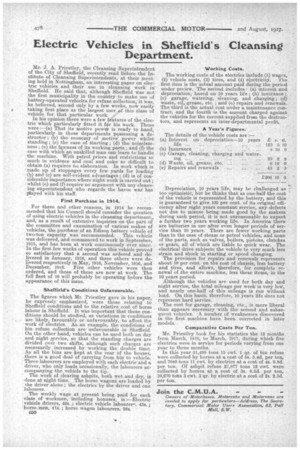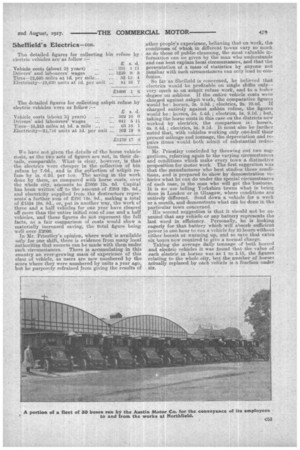Electric Vehicles in Sheffield's Cleansing Department.
Page 14

Page 15

If you've noticed an error in this article please click here to report it so we can fix it.
Mr. J. A. Priestley, the Cleansing Superintendent of the City of Sheffield, recently read before the Institute of Cleansing Superintendents, at their meet mg held in Nottingham, an interesting paper on electric vehicles and their use in cleansing work in Sheffield. He said that, although Sheffield was not the first municipality in the country to make use of battery-operated vehicles for refuse collection, it was, he believed, second only by a few weeks, now easily taking first place as the largest user of this class of vehicle for that particular work.
In his opinion there were a few features of the electric which particularly fitted it for his work. These were :—(a) That its motive power is ready to hand, particularly in those departments possessing a destructor; (b) the economy of motive power whilst standing ; (c) the ease of Starting ; (d) the noiseleSsness ; (e) the fewness of its working parts; and (f) the ease with which an unskilled man can learn to handle the machine. With petrol prices and restrictions so much in evidence and coal and coke so difficult to obtain (a) requires no elaboration. In work which is made up of stoppages every few yards for loading (?) and (c) are self-evident advantages ; (d) is of considerable importance where night work is carried out ; whilst (e) and f) require no argument with any cleansing auperinteudent who regards the havoc war has riayed with his staff.
First Purchase in 1914.
For these and other reasons, in 1914 he recommended that his Council should consider the question of using electric vehicles in the cleansing department„ and, as a result of extensive inquiries on t;he part of the committee and examination of various makes of vehicles, the purchase of an Edison battery vehicle of two-ton capacity was recommended. This vehicle was delivered, and commenced to work in September, 1915, and has been at work continuously ever since. In the first few weeks of operation this vehicle proved so satisfactory that a second was ordered and delivered in January, 1916, and three others were delivered respectively in May, 1916, November, 1916, and December, 1916. Five other vehicles were then ordered, and three of these are now at work. The full fleet of 10 will probably be operating before the appearance of this issue.
Sheffield's Conditions Unfavourable.
The figures which Mr. Priestley gave in his paper, he expressly emphasized, were those relating to Sheffield conditions and to the relative cost of horse labour in Sheffield. It was important that these conditions should be studied, as variations in conditions are likely, favourably or unfavourably, to affect the work of electrics. As an example, the conditions of bin, refuse collection are unfavourable in Sheffield. On the other hand, vehicles can be used both on day and night service, so that the standing charges are divided over two shifts, although such charges are necessarily increased by working the double time. As all the bins are kept at the rear of the houses, there is a good deal of carrying from bin to vehicle. Three labourers are employed with each electric and a driver, who only loads occasionally, the labourers accompanying the vehicle to the tip. The work of clearing ashpits, both wet and dry, is done at night time. The horse wagons are loaded by the driver alone ; the electrics by the driver and one labourer.
The weekly wage at present being paid for each class of workmen, including bonuses, is :—Electric vehicle drivers, 465. ; electric vehicle labourer. 43s. ; horse,men, 41s.; horse wagon labourers. 38s.
050 Working Costs.
The working costs of the electrics include (1) wars, (2) vehicle costs, (3) tires, and (4) electricity. The first item is the actual amount paid during the period under feview. The second includes: (a) interest and depreciation, based on 10 years life ; (b) insurance ; (c) garage, watering, cleaning, and charging ; (d) waste, oil,.grease, etc. ; and (e) repairs and renewals. The third is the actual cost under a maintenance contract, and the fourth is the amount charged against the vehicles for the current supplied from the destructors, and represents an inter-departmental profit.
Depreciation0 years life, may be challenged as b too optimistic, but he thinks that as one-half the cost of the vehicle is represented by the battery, and this is guaranteed to give 100 per cent, of its original efficiency after eight years constant service, any defects not due to misuse being made good by the makers during such period, it is not unreasonable to expect a further two years working life. In America there are batteries in use after even longer periods of service than 10 years. There are fewer working parts than 'in the case of steam or petrol vehicles, and none of the parts, such as valves, boilers, pistons, clutches or gears, all of which are liable to quick wear. The electrical drive subjects the vehicle to very much less strain and shock in starting or speed changing. The provision for repairs and renewals represents about 10 per cent, on the cost of chassis, less battery and tires, and allows, therefore, for complete renewal of the •entire machine, less these items, in the 10 years period. Although the vehicles are used for both day and night service, the total mileage per week is very low, and nearly one-half of this mileage is run without load. On this basis, therefore, 10 years life does not represent hard service. The cost for garage, cleaning, etc., is more liberal than appears necessary with the second and subsequent vehicles. A number of weaknesses discovered in the first machine have been corrected in later models.
Comparative Costs Per Ton.
Mr. Priestley took for his statistics the 12 months from March, 1916, to March, 1917, during which five electrics were in service for periods varying from one year to three months. In this year 51,498 tons 15 cwt. 1 qr. of bin refuse were collected by horses at a cost of 5s. 5.4d. per ton, and 7040 tons Fl cwt. by electrics at a cost of 4s. 9.8d. per ton. Of ashpit refuse 27,877 tons 12 cwt. were collected by horses at a cost of 3s. 8.5d. per ton, 10,670 tons 3 cwt. 3 qr. by electric at a cost of 2s. 2.3d. per ton.
Join the C.M.U.A.
Owners of Motorbuses. Motorcabs and Motorvans are invited to apply for particulars—Address, The Secretary, Commercial Motor Users Association, 83, Pall Mall, S.W.
We have not given the details of the horse vehicle costs, as the two sets of figures are not., in their details, comparable. What is clear, however, is that the electrics were cheaper in the collection of bin refuse by 7.6d., and in the collection of ashpit refuse by is. 6.2d. per ton. The saving in the work done by them, as compared with horse costs, over the whole city, amounts to £1050 12s. 6d. Capital has been written' off to the amount of £292 12s. 6d., and electricity supplied from the destructors represents a further sum of 2191 14s. 8d., making a total of £1534 19s. 8d., or, put in another way, the work of three and a half vehicles for one year have cleared off more than the entire initial cost of one and a half vehicles, and these figures do not represent the full facts, as a fair comparison of costs would show a materially increased saving, the total figure being well over 22000.
In Mr. Priestley's opinion, where work is available only for one shift, there is evidence from many local authorities that success can be made with them under such circumstances. There is accumulating in this country an ever-growing mass of experience of this class of vehicle, as users are now numbered by the score where they were numbered by units a year ago, but he purposely refrained from giving the results of other people's experience, believing that on work, the conditions of which in different towns vary so much as do those of public cleansing, the most valuable information can be given by the man who understands and can best explain local circumstances, and that the presentation of a mass of statistics by anyone not familiar with such circumstances can only lead to confusion.
So far as Sheffield is concerned, he believed that eleetrics would be profitable on single shifts only— very much so on ashpit refuse work, and to a lesIter degaee on a,shbins. If the entire vehicle costs were charged against ashpit work, the comparative figures would be : horses, 3s. 8.3d. ; electrics, 2s. 10.4d. If charged entirely against ashbin refuse, the figures would be : horses, Ss. 5.4d. ; electrics, 5s. 9.Id. ; but, taking the horse costs in this case on the districts new worked by electrics, the comparison is : horses, 6s. 8.4d. ; electrics, 5s. 9.1d. It must also be further noted that, with vehicles working only one-half their present mileage and tonnage, the depreciation and repairs items 'would both admit of substantial reductions.
• Mr. Priestley concluded by throwing out two suggestions, referring again to the varying circumstances and conditions which make every town a distinctive proposition for motor work. The first suggestion was that the manufacturer who best studies those conditions, and is prepared to show by demonstration vehicles what he can do under the special circumstances of each case, is the man who will get the business. It is no use telling, Yorkshire towns what is being done in London or in Glasgow, where conditions are entirely different. Send down a vehicle for a week or a month, and demonstrate what can be done in the particular town concerned. His second suggestion is that it should not be assumed that any vehicle or any battery represents the last word in efficiency. Personally, he is looking eagerly for that battery which will absorb sufficient power in one hour to run a vehicle for 23 hours without either boosts or warming up, and so save that extra six hours now required to give a normal charge. Taking the average daily tonnage of both horsed and electric vehicles it was found that the value of each electric in horses was as 1 to 5.15, the figures relating to the whole city, Nit the number of horses actually replaced by each vehicle is a fraction under six.




















